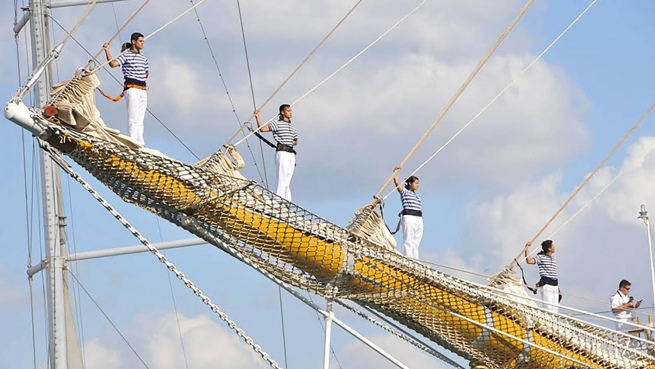Although every time the Frigate Libertad enters a port they are tiny, standing in line on the masts with their horizontal blue striped uniforms, the role that the gavieros and gavieras play in navigation is not minor at all and their task is not is for anyone: The deployment of the ship’s more than 2,500 square meters of sails largely depends on them.
The function of these crew members is to release the sails when they are tied down, and to fasten them again once they have been retracted, and for this they must climb quickly until they reach their position, maneuver like acrobats between ropes and lines without losing their balance held by harnesses, withstand seasickness from the rocking of the boat and don’t be put off by how narrow the deck can look, 10, 20 or 30 meters below your feet.

The training ship of the Argentine Navy, which is visiting Mar del Plata until Tuesday, as part of the international voyage “Velas Latinoamérica 2022”, It has almost 50 gavieros and gavieras that are distributed in groups of 16 people for each of the three masts: the trinquete, in the bow: the largestin the center of the boat, and the mizzen, towards the stern.
The Fragata Libertad is 104 meters long, 14.3 meters wide, has a total area of 2,652 square meters with a sail made up of 27 sails, and a maximum height of 50 meters at its main mast.
“When the boatswain blows the whistle, we know that we have to stop what we are doing and we have to get to the positions as quickly as possible,” he explained to Télam Mirna Flores, born 25 years ago in San Pedro, Jujuyand one of the seven women who occupy those positions.

As he pointed out, before being assigned to the masts, all deck personnel must pass a vestibular test, an evaluation carried out by the Air Force similar to those that astronauts usually carry out, to determine if they suffer from vertigo or dizziness. “During navigation maneuvers, some bear it better and others suffer more from the sickness of the sea and take a Dramamine, depending on the state of the sea,” he commented, and assured that in his position on the foremast he carries it quite well, although he recalled a nearly two-week test sail in 2021, which was “terrible as far as the boat moved”.
Débora Marín, 29 years old and a native of the Tucuman town of Donato Álvarez, is another of the topmen and acknowledged that “at first it’s scary, but it’s until you get used to it.” In her case, she occupies one of the positions at one of the ends of one of the booms that cross the mainmast, more than 15 meters above the deck. “It feels very emotional to be there, for example when we enter a port, and navigation is very demanding, you have to be very physically fit. When it’s cold it’s hard,” she said.
Erasmo Barreto, 24 years old, and originally from Caá Catí, Corrientes, made his debut in the position of topman in this navigation within the framework of this international voyage, and admitted that “at first one is afraid, but later it passes, and one feels a lot of adrenaline”. “Even if we are sleeping, if the whistle sounds we have to go up on deck, prepare the harnesses, climb on the masts, and there we loosen the sails and pass the lines through the winches to unfurl the sails,” he explained on board the Frigate Libertad, moored at the Mar del Plata Naval Base.
Joel Ibáñez, a native of the Jujuy town of Perico23, also debuted in the position in this navigation, and assured that it requires “significant physical effort”, and that “entering the port from that position gives tremendous pride”.

The distribution of roles in each mast has its own jargon on board, as detailed: the topmen of the mast in front are called “Tigers”, because it is said that “they are the fastest”; the older ones were baptized “turtles” due to its presumed slowness – “it takes longer because the stick is higher”, defended Marín, who occupies one of those places – and the “ravens” on the mizzen mast, which are usually blackened by soot from the aft funnel.
The Fragata Libertad is 104 meters long, 14.3 meters wide, has a total area of 2,652 square meters with a sail made up of 27 sails, and a maximum height of 50 meters at its main mast.

















